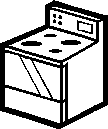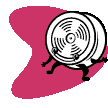Carbon Monoxide
PROTECT YOURSELF AND YOUR FAMILY FROM THE SILENT KILLER!
What is Carbon Monoxide (CO)?
You can't see it, hear it, taste it, or smell it.
Carbon monoxide is a colorless, odorless, extremely poisonous and explosive gas which causes 1,500 accidental deaths and more than 10,000 injuries each year. CO is slightly lighter than air and mixes throughout the atmosphere. It is a by product of incomplete combustion, produced when fuels such as natural gas, propane, heating oil, kerosene, coal charcoal, gasoline, or wood are burned with insufficient air.
What are the Effects of CO Poisoning?
Mild Exposure: Flu like symptoms including slight headache, nausea, vomiting, and fatigue.
Medium Exposure: Severe headache, drowsiness, confusion, and a fast heart rate. Prolonged exposure to medium levels of CO can result in death.
Extreme Exposure: Loss of consciousness, convulsions, heart, and lung failure, possible brain damage, and death.
While everyone is at risk for CO poisoning, unborn babies, infants and young children, senior citizens, and people with heart and lung problems are at a higher risk due to their greater oxygen needs.

What are Some of the Sources of CO?
- Gas Stoves, Hot Water Heaters
- Gas or Oil Heaters, Charcoal Grills
- Gas Space Heaters, Wood Burning Stoves
- Fireplaces, Lawnmowers, Pilot Lights
- Car Exhaust Fumes, Tobacco Smoke

How to Prevent CO Poisoning
There are many simple precautions you can take to protect your family from this silent killer.
- Inspect flues and chimneys for cracks, corrosion, holes, debris or blockages.
- Buy fuel powered heaters with automatic shut off features.
- Fuel heaters in well ventilated areas.
- Service heaters before the first use of the winter season.
- Open windows periodically to air out your house. Homes with energy efficient insulation can trap CO polluted air inside.
- Use a gas stove for cooking purposes only.
- Operate gas burning appliances in a well ventilated room.
- Never leave a car running in a garage.
- Use charcoal grills outdoors, never indoors.
- Install and maintain carbon monoxide detectors.
What Features to look for when Choosing a CO Detector:
- Stops automatically within minutes when fresh air clears CO
- Manual reset button and test button.
- Digital warning light and light to indicate power on.
- Horn that sounds 85 decibels.
- Approval from a testing laboratory, such as Underwriters Laboratory.
- With plug in models, power cord at least 6 feet long.
- Battery/sensor pack on battery operated models that lasts a few years.
- For use in recreational vehicles, buy an AC model or 12 volt version.
Installing your CO Detector
Install CO Detectors near bedroom areas and family rooms. Do not install them near air vents or fans. Place them in the center of the room where they can measure the overall general atmosphere. For extra protection, place one about fifteen feet away from your home's heat source. To avoid nuisance alarms do not put a CO detector in the kitchen, garage, utility room, basement, bathroom or unventilated rooms where cleaning supplies are kept. Chemical fumes, humidity and very hot or very cold temperatures will affect the performance of a detector.
Maintaining your CO Detector
Keep your CO detectors dust free by vacuuming air vents regularly. Test your CO Detectors each week simply by pressing the Test/Silence button to make sure that the alarm sounds. If the detector ever fails to test properly, have it repaired or replaced immediately.
What to do if your Alarm Sounds
If the alarm sounds and anyone in the house has symptoms of CO poisoning:
- Leave the house immediately and call 9-1-1 or an emergency response number.
- Have someone contact your fire department and consult your fuel company.
If your alarm goes off and no one has symptoms of CO poisoning:
- Turn off all fuel burning appliances that are possible sources of CO.
- Contact your Fire Department
- Contact your fuel company or a licensed technician to repair the problem









